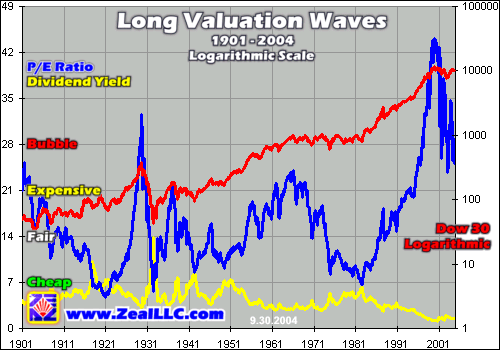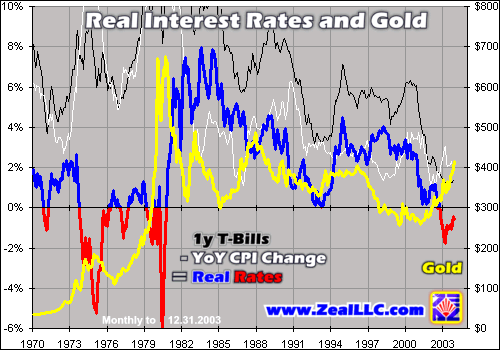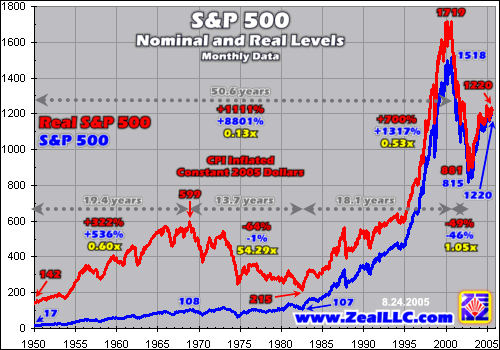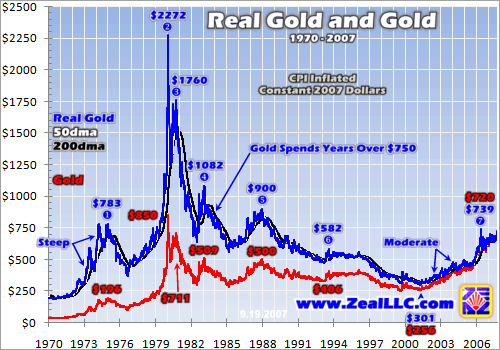Further beneath the 2004 message of mine, I offer several weblinks to more in-depth reading, if you're interested.
(And by the way, I buy 1-oz. American Gold Eagles, Canadian Maple Leafs, and South African Krugerrands, and buy and sell them at a local coin shop. I also keep them in a safe deposit box at my bank.)
Happy reading!
-----------------------------------------------------------------------------------------------
(Begins my 2004 message...)
Check out these four long-term graphs!
Century of the Dow 1901-2001

Stock Market Long Valuation Waves 1901-2004

Real Interest Rates and Gold 1970-2003

Debt-to-GDP ratio 1916-2002

Basically, the stock and gold markets tend to perform opposite of each other over very long periods of time, running in about 35-year "Summer-Winter" cycles where one does well for 15-20 years while the other is slumping. This became apparent around 1971 when gold was unpegged from the dollar. You'll also notice the super-long debt wave that seems to repeat itself following every other stock cycle. Since debt and real estate often go hand-in-hand, the real estate market tends to perform well when the debt-to-GDP ratio is flat or rising (which is about 75% of the time). It does absolutely horrible when the Debt Bubble collapses and declines (i.e., about 25% of the time).
The ultimate fundamental driving mechanisms for these long cycles are stock valuations and debt levels. The general stock markets become historically overvalued at the end of "Summer," and undervalued at the conclusion of "Winter." Debt levels begin skyrocketing relative to GDP during every other Summer, they peak into early Winter, they collapse and decline throughout the remainder of Winter, and finally, the Debt Bubble hibernates and lies dormant until the cycle after the next.
According to the charts, the pivotal years when the markets turned major corners were 1929, 1949, 1966, 1980, and 2000. We're currently in the "Winter Half" of the cycle, and the next pivotal year will probably take place around 2015-2020.
The currency is usually strong during the long period when stock valuations are rising (i.e., the "Summer Half"), and is generally weak when stock valuations are falling (i.e., the "Winter Half"). Gold is a classic hedge against a weak currency.
Nevertheless, during the Winter Half, one of two things can sustain the currency's value:
1. The currency being backed by gold, where foreigners can automatically exchange the money for a fixed amount of gold (i.e., the U.S. dollar in the 1930s & '40s).
2. The currency's economy has a large trade surplus (i.e., Japan in the 1990s & 20-00s).
In either situation, the currency will still offer foreign investors something of value during an otherwise treacherous economic period of depression or rampant inflation.
The U.S. dollar did not offer this protection during 1971-1980, nor from 2000 through the present, so its value declined in the past and is currently declining today. And with the giant Debt Bubble on the verge of collapsing, you'd better buy gold now! It carries no debt -- unlike paper money, which can become seriously devalued when foreign investors no longer believe the currency offers them something of value. (At that point, they sell it off.) It doesn't matter if the domestic economic environment is inflationary or deflationary; the currency will lose serious value if foreigners dump it. And remember, gold is a classic safe-haven "hedge" against currency devaluation.
I'll continue investing in gold until sometime around 2015-2020, then I'll sell most of it and buy into Dow Jones and/or S&P 500 index funds (and I'll buy a house at that time, too). Then sometime during the 2030s decade, I'll pull out of the stock market funds (but keep the house), and put the money into either gold or platinum at that time, depending on the circumstances.
Hope this helps!
(Ends my 2004 message.)
-----------------------------------------------------------------------------------------------
Articles for further reading:
"Century of the Dow"
http://www.zealllc.com/2001/century.htm
(This was the first investment-related article I read in early May 2003, which immensely sparked my enthusiasm in following the markets and buying gold.)
"Valuation Wave Reversion"
http://www.zealllc.com/2003/wave3.htm
(Further discusses the long cycles in the stock market.)
"Real Rates and Gold"
http://www.zealllc.com/2004/realgold6.htm
(Discusses how a phenomenon called negative real interest rates is one of the strongest driving forces for a bull market in gold.)
"Gold in the Information Age"
http://www.zealllc.com/2002/digigold.htm
(If you read just one article about the 10,000-year history of money, along with a prediction of the future of money in the 3rd Millennium A.D., then let it be this one.)
"Real Estate Bubble"
http://www.zealllc.com/2005/rebubble.htm
http://www.zealllc.com/2005/rebubble2.htm
http://www.zealllc.com/2005/rebubble3.htm
(A three-part series written in 2005, regarding the causes and characteristics of the market bubble in real estate.)
"Apocalypse This Way Comes"
http://www.financialsense.com/editorial ... /0902.html
(This article, in combination with the "Debt-to-GDP Ratio 1916-2002" graph above, convinced me back in 2003 that another American Great Depression is headed our way.)
Good gold websites:
http://www.kitco.com
http://www.gold-eagle.com
http://www.321gold.com
And finally, this has been the opening home page of my web browser since 2003:
http://www.kitco.com/charts/livegoldw.html




